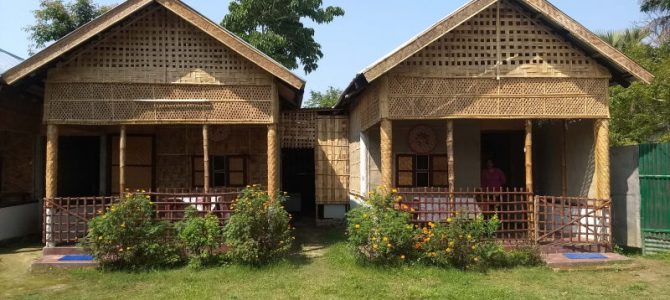The title of this post is misleading when it says, ‘City Focus’. Instead, we are going to focus on a unique village that has settled on the largest river island in the world. We will also see the unique Satra culture of Majuli’s settlement and why Majuli is perfect getaway for a day or two. Majuli holds a special place in our hearts, because we celebrated 3 years of our marriage on this island.
Geography of Majuli
Majuli is a village on an island at the confluence of Brahmaputra and Subansiri rivers in Assam. It is the world’s largest river island. On the southern bank across the island is Jorhat district, with Jorhat city about 18 km away from the ferry point to Majuli. To the north of the island across the confluence of the two rivers is North Lakhimpur district, with the city itself about 40 km away from the northern ferry point to Majuli. The northern shore of Majuli is also where the Subansiri river, which originates in Arunachal Pradesh and flows through Daporijo and Ziro, joins the Brahmaputra river. A road connects Majuli island to Dhemaji city via Jengraimukh bridge that crosses from the island to the mainland at a place where the river flows around the north of the island in a narrow channel.
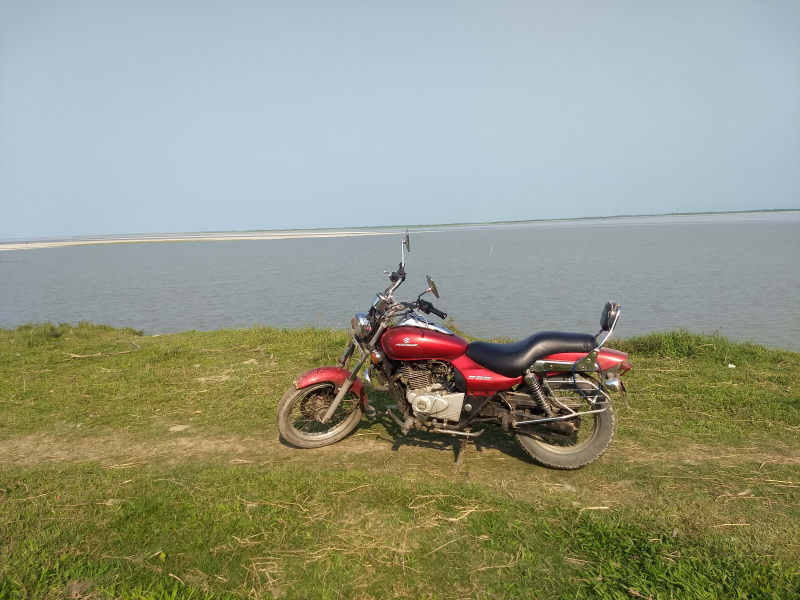
Majuli is the largest river island in the world and is at the confluence of Brahmaputra and Subansiri rivers.
Majuli is a flat expanse of land, slightly elevated above the rest of the river, with very little undulation and no hills. During monsoon, Brahmaputra river often swells and stops ferry services between Majuli’s south to Jorhat and north to North Lakhimpur. The bridge to Dhemaji also gets cut off during seriously heavy rains. As a result, Majuli is cut off from the rest of India. The river often floods the island, causing some families to leave and stay in mainland Assam during peak monsoon. The families leave the island during late winter before the onset of monsoon.
People of Majuli
The people of Majuli belong to a tribe named Mishing and speak a language of the same name. Unlike Assamese, which originated from Sanskrit and was patronised by the long-serving Ahom dynasty, Mishing is closer to the languages of Arunachal Pradesh and Nagaland, with elements of Burmese and Mongol. The language is completely different from Assamese and Bengali, the two most commonly spoken languages in Assam.
Youngsters from Majuli are fluent in Assamese, which they use for communication while stepping into mainland Assam for business, work and shopping. Plenty of them also have good command of Hindi and English. But the elders in the village have rarely left the island and their linguistic skills are summed up best in the words of a young restaurant owner we talked to in Majuli as follows, “Meri daadi ko toh Assamese hi nahi aati. Hindi aur English toh duur ki baat hai!”, which translates to, “My grandmother cannot speak even Assamese. Hindi and English are way out of her scope!” To give you an idea, Hindi and English are the two most spoken languages in the country today, especially in the metro cities and tier 2 cities. But there are sections of Indians for whom both the languages are irrelevant, which keeps bringing back questions on the validity of trying to force a national / official language (or languages) for all of India. This is a paradox and an important point that both of us rather enjoyed and appreciated about India throughout the trip, especially in remote regions.
The occupation of Majuli natives varies based on the community they live in. Majuli is divided into settlements called ‘Satras’, which each Satra dedicated to an occupation. There are 17 Satras, but in a 2-3 day or even a week-long trip to Majuli, you’ll usually catch only 4 – 5. This is because Satras are highly seasonal and you’ll never see all 17 Satras active at the same time. Many of them work more during spring, some during summer and yet others during winter. The occupation depends on the availability of raw materials and the occasions for which that occupation is important. To observe all 17 Satras in action, you’d have to stay in Majuli for a year.
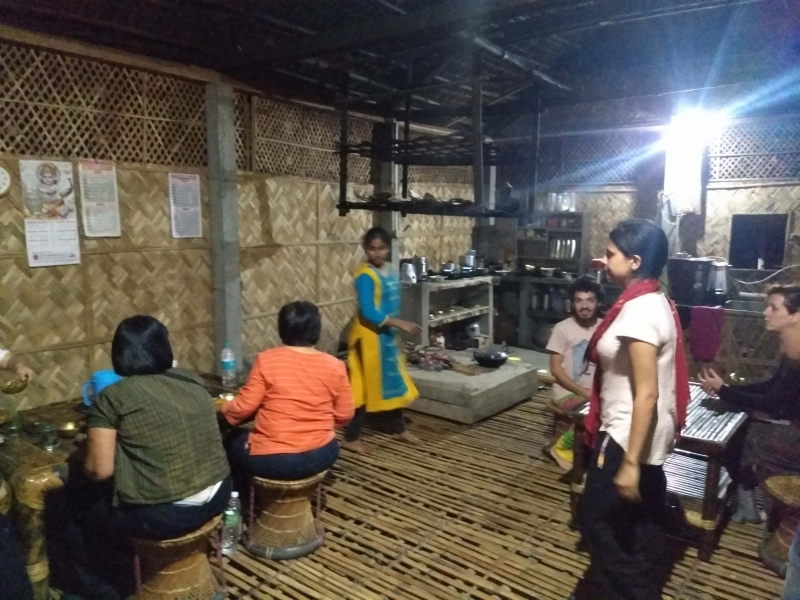
Running a home stay with a kitchen for providing food is a steady occupation for Mishings.
Some of the important occupations in Majuli are agriculture (common to the whole island), pottery, mask making, boat building and weaving. Tourism has brought some other steady occupations such as hosting home stays, operating restaurants and shops, renting out bicycles, riding ferries between the mainland and island and carrying items between the two as porters / courier.
There is no common faith among the tribes of Majuli. Most of them follow Hinduism with Lord Krishna being their main deity. Locals along the north of the island (especially near Jengraimukh) follow Christianity, like most of the tribes in north-eastern Himalayas.
Here are the best places to see in Majuli.
Kamalabari Satra
This is the first Satra you will see when the ferry from Jorhat docks in Majuli. This Satra is mainly commercial with shops and home stays. Most foreigners stay in Kamalabari Satra, because of the availability of stylish home stays in the form of stilted bamboo cottages. These home stays also provide their own bicycle rentals. Plenty of them come with air conditioners, WiFi access and other modern creature comforts. We stayed away from them because they didn’t suit our budget.
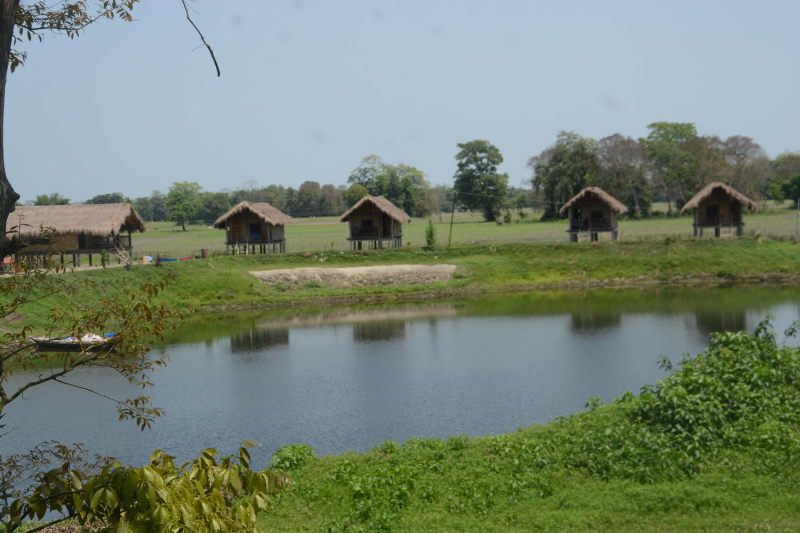
Stilt home stays at Kamalabari Satra look rudimentary, but are often air-conditioned and provide WiFi.
One place worth checking out at Kamalabari Satra is the riverside viewpoint, where one can relax in the evening during sunset and spot plenty of river dolphins. At the river view point, we made friends with four young men, three of them Bengali-speaking Assamese and one from Nagaland, who were bicycling around Majuli and had pitched a tent on the grass near the river.
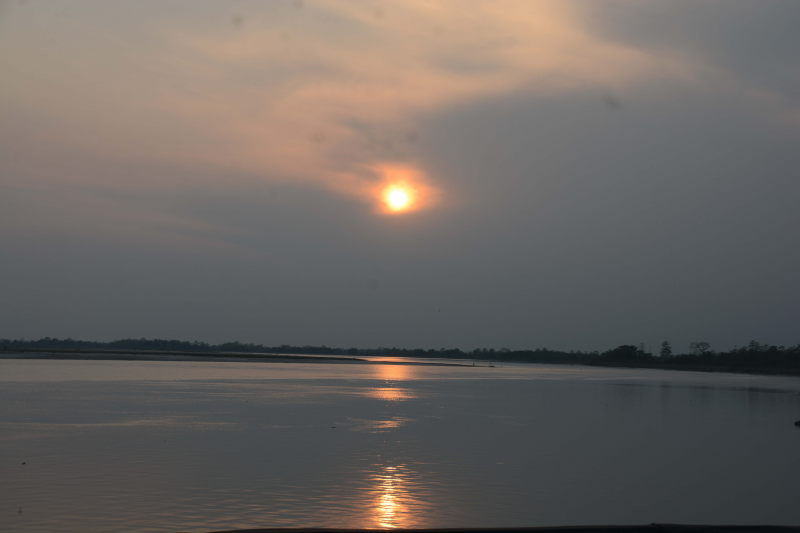
Sunset as seen from Kamalabari Satra
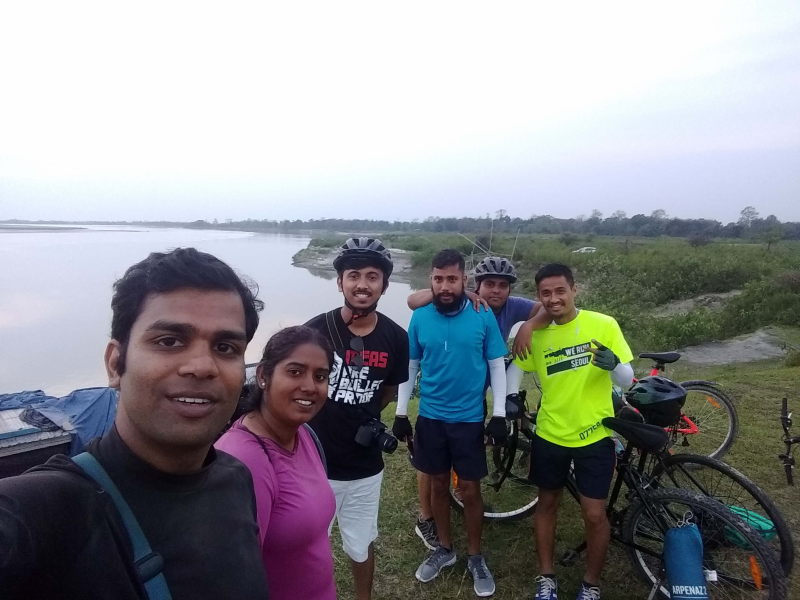
From left to right: The two of us (Hari and Priya), Saikat, Gautam, Biprojit (all from Karimganj in Assam) and Wapang (from Dimapur, Nagaland). The four of them had arrived at Majuli on their own bicycles and were also pedalling around the island. Later in the trip, we stayed with Wapang at Dimapur and with a friend of Gautam’s at Karimganj.
Kamalabari is not to be pronounced like the word ‘Kamal’, meaning a lotus. In typical eastern Indian style, it should be pronounced as ‘Com-laa-baadi’, with the syllable ‘com’ matching Internet’s ‘.com’ and the ‘r’ matching a soft ‘d’ sound.
Garmur Satra
Taking Majuli’s main highway that goes from Kamalabari at the southern end to Jengraimukh at the northern end, the first township you see is Garmur Satra. This is a highly commercial Satra with petrol pumps, banks, provision shops, medical shops, restaurants, coffee shops, bakeries and a super market. Thankfully, the price of petrol in the pumps was the same as that of the rest of Assam.
It is at Garmur Satra that you will find cheaper, no-frills homestays. These are beautiful wooden, brick or bamboo cottages with basic facilities like a mosquito net over the bed, a ceiling fan and tap water with no water heater. We found even these a little over budget, but then it was our anniversary. 🙂
Auniati Satra
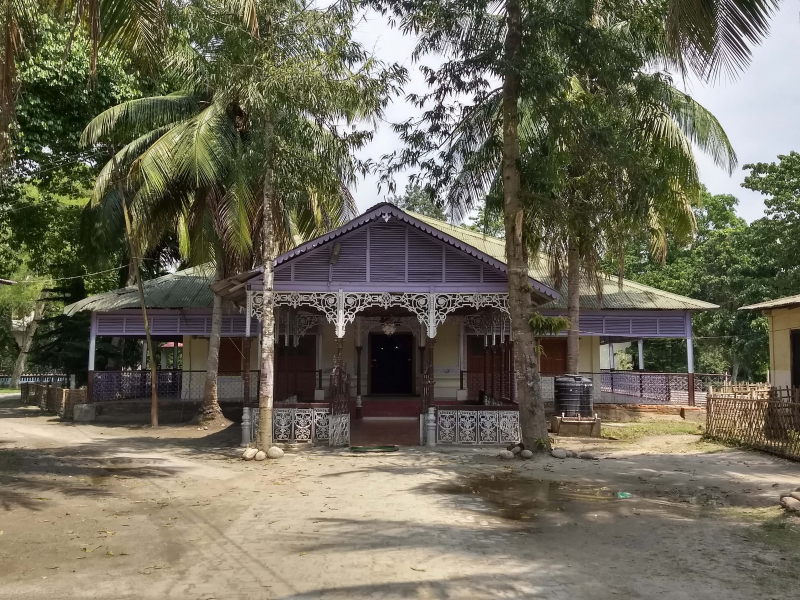
Temple at Auniati Satra
This is the most religious Satra on island with the presence of a Shri Krishna temple in the centre. The Auniati Satra is also the gathering point for all the tribes of Majuli, during public celebrations, when the grounds of the temple are used as a convention centre and a performance stage.
Samaguri Satra
This Satra is easily one of the most eye-catching Satras in Majuli, with its focus on making clay masks used in folk dances. There is a small museum where the masks are exhibited. A presenter tells you the story of the masks in Assamese. They will manage in broken English if you ask them nicely, but they do not speak Hindi. In fact, this is a tip for all of north-east India, barring Sikkim and Arunachal Pradesh. English gets you far more ahead than Hindi does. Their native languages are derived from Burmese and Mongol, with no similarity to Hindi. Most of them have attended or are studying at Christian missionary run schools and have learnt English.
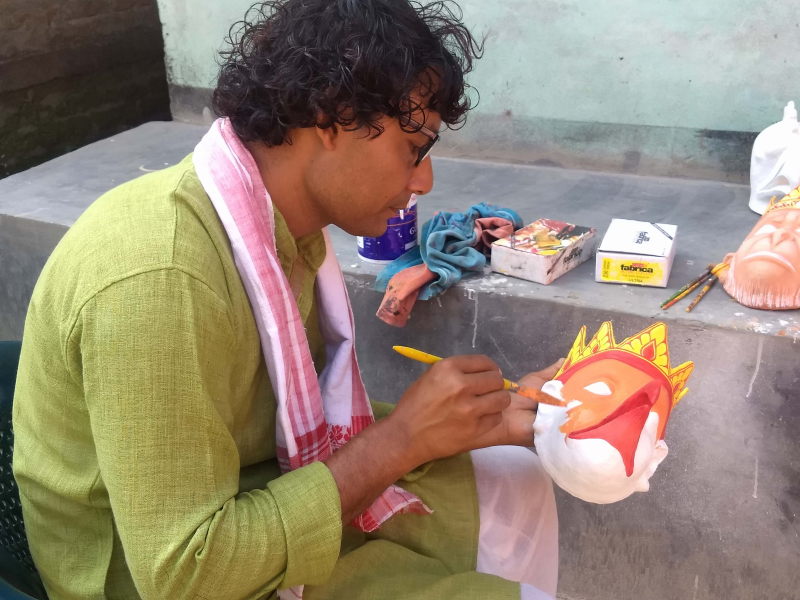
An artisan finishes a mask at Samaguri Satra.
At this Satra, you will also see mask making in action, as the artists start with a wireframe of bamboo or straw. Then they apply clay on top of the wireframe and bake the mask. Finally, they finish the mask by painting with acrylic paint. These days, clay masks have been replaced by plaster of paris (PoP) masks, since plaster is easier to work with and is more durable.
Dakhinpat Satra
This Satra is at the southern tip of Majuli. The Satra is know for its dance forms. We went to Majuli around the same time as Bihu (during April), which is new year’s day as per traditional Assamese calendar, similar in timing to Maharashtra’s Gudi Padwa, Andhra Pradesh’s Ugadi and Tamil Nadu’s Varsha Piraippu. So dancers from Dakhinpat were out on the streets dancing the traditional Bihu dance around the village. They performed at the porches of every house in the village and were paid Bakshis (a prize for performance) by the home owners.
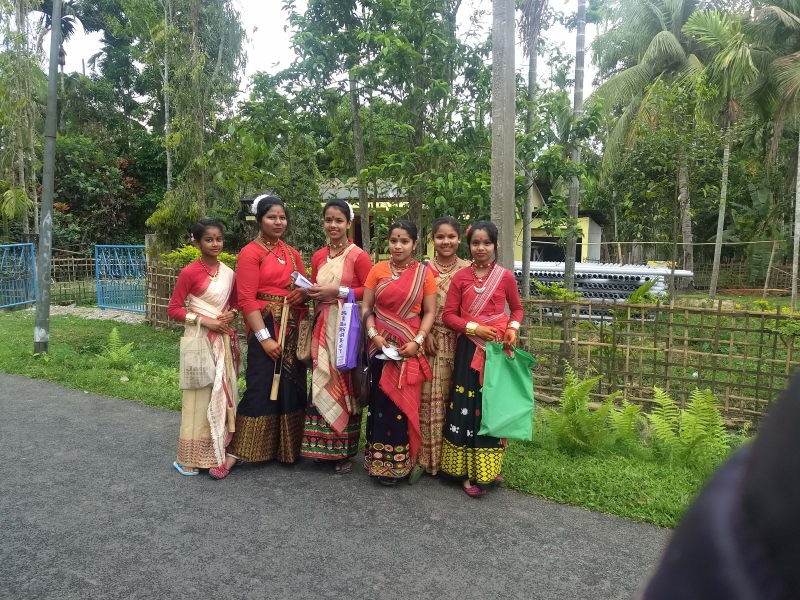
Young girls in traditional attire dance during Bihu.
Salmora Satra
This Satra is known for pottery. The Satra is not very active during monsoon (March – July in north-east India), due to the stickiness of clay during these months and the inability to shape it as desired. But if you approach a household to demonstrate, they will oblige, although for a very steep price. The quoted price drove us away from this Satra 😀
Dikhoumukhia Satra
This Satra is popular for boat-building. Boats are made of bamboo and wood. Throughout the shore of the river at this Satra, you will see boats at various stages of completion, right from the frame to a finished vessel capable for taking on the waters of Brahmaputra.
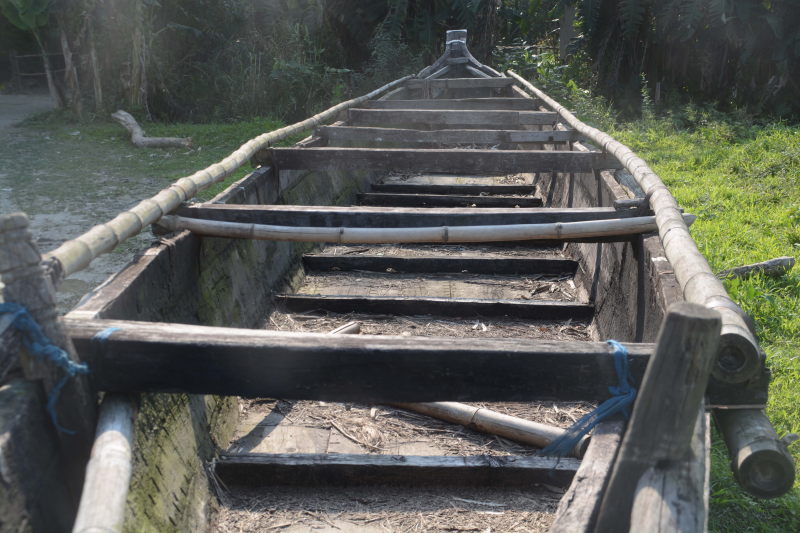
The frame of a boat being built at Dikhoumukhia Satra.

A finished boat on the river at Dikhoumukhia Satra.
In addition, the women at many of these Satras are experts at weaving. They use hand-operated looms to wave shawls and drapes (known as Mekhela Chadar in Assam).
Reaching Majuli
Here are some ways to reach Majuli.
Ferry: Unless you are driving your own vehicle and using the road from Dhemaji, it is necessary to cross the Brahmaputra river by ferry in order to reach Majuli. One ferry point is at Jorhat to the south of the river which takes you to Kamalabari Satra, while another is at North Lakhimpur to the north of the river which takes you to Jengraimukh. You can drive your own vehicle on board the ferry and drive off at the other end. Such a service is called “Roll on, Roll off” (RoRo for short).
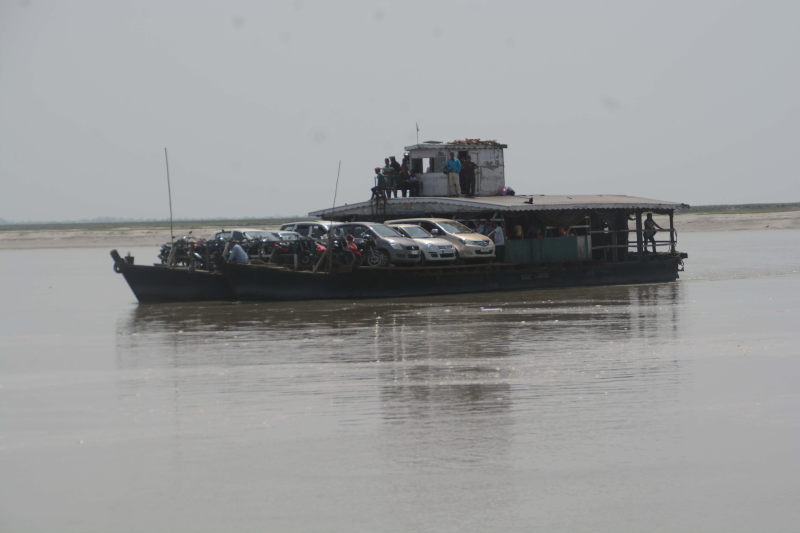
A RoRo ferry commuting between Jorhat and Majuli, with cars and motorbikes on board.
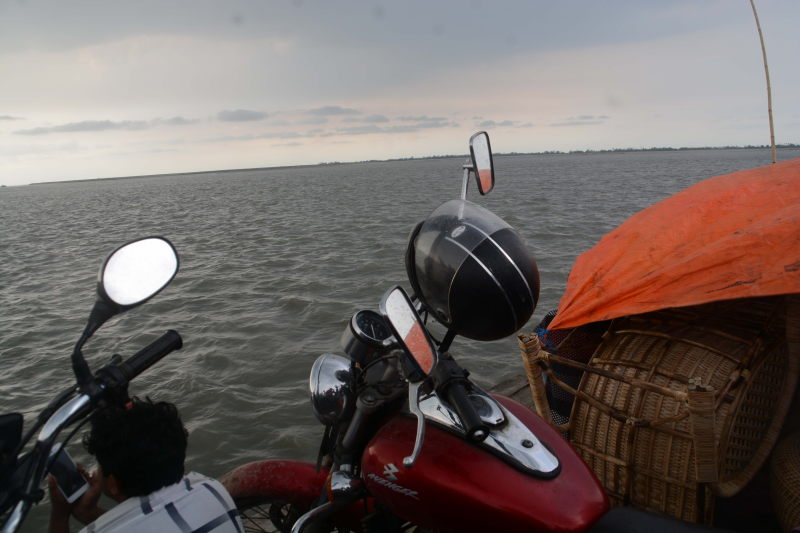
Our motorbike aboard a RoRo ferry between Jorhat and Majuli.
Air: The nearest airport is at Jorhat. But the airport is 7 km from the city and is referred to a Rowriah, due to the name of the locality. IndiGo flies between here and New Delhi, Kolkata and Guwahati. Two other airports with more frequent services are Guwahati and Dibrugarh, from where one can take a train or bus to Jorhat.
Train: Jorhat has a railway station named Jorhat Town, but it does not have frequent services. Some important trains like Guwahati – Dibrugarh Intercity Express pass through Jorhat Town. But the more well-connected train station is at Mariani, a town 16 km south of Jorhat, with frequent shared taxi and bus services to Jorhat city. Mariani is an important station on the route, Sealdah – New jalpaiguri – New Bongaigaon – Rangiya – Guwahati – Lumding – Mariani – Dibrugarh.
Important trains like New Delhi – Dibrugarh Rajdhani have a 5-minute halt at Mariani for passengers to/from Jorhat. Other long-distance trains like Chennai – Dibrugarh Express and Brahmaputra Mail also pass through and halt at Mariani rather than at Jorhat Town.
Tip: If you are at Mariani, look for a road-side stall with burgers on the Mariani – Jorhat highway. The burgers are amazing.
Bus / taxi: Buses to Jorhat and to North Lakhimpur are available from all around Assam, with the most important hubs being Guwahati, Rangiya, New Bongaigaon, Barpeta, Tezpur, Sibsagar, Dibrugarh and Tinsukia. You can also hire a direct tourist taxi for Majuli from Guwahati, Jorhat, Sibsagar, Dibrugarh and Tinsukia.
Self-drive: Two national highways run parallel to each other in Assam, one on each side of Brahmaputra river. Either can be used to reach Majuli. The more popular highway is New Bongaigaon – Rangiya – Guwahati – Nagaon – Jorhat – Sibsagar – Dibrugarh – Tinsukia, running parallel to the river to its south. At Jorhat, you can reach Kamalabari Satra by ferry. Another highway runs parallel to the river to its north as New Bongaigaon – Rangiya – Orang – Tezpur – Gohpur – Laluk – North Lakhimpur – Gogamukh – Dhemaji – Silapathar. From here, one can reach the northern ferry point that takes you to Jengraimukh in Majuli. Our north-eastern trip was done on our motorbike. We used drove to Jorhat and RoRo-ed our motorbike between Jorhat and Majuli to and fro.
You can drive past North Lakhimpur in the direction of Dhemaji. At Gogamukh, taking a southward turn to the right will put you on the Gogamukh – Ghilamora – Jengraimukh highway, where a river bridge crosses over to the island across a part of the Subansiri river, which narrows considerably.
Getting around Majuli
Your own vehicle: Your own vehicle is the best way to get around Majuli. Since we used our own motorbike, we had it very easy. We could explore a large part of the island. There are petrol pumps in Garmur Satra, where you can fill up. But no petrol pumps can be found elsewhere on the island.
Taxi: If you have booked a taxi from a major city in Assam, this taxi will RoRo with you to Majuli. The same taxi will show you around the island. We are not sure if there are taxi stands and hence taxis within the island itself. We never had to look for them. It may be worthwhile checking at Kamalabari or Garmur Satra.
Rented bicycles: This is the preferred mode of transport among the foreign tourists in Majuli. Home stays themselves or dedicated bicycle rentals can rent you bicycles priced per day. Although a good option, personally we found the rent a bit too steep for our liking. Touristy prices are catching up with the island.
What to eat at Majuli
You’d be in paradise if you love fresh water fish. Fish is cooked in mustard gravy and served with rice and a assortment of chutneys / dips. But we are vegetarian and stuck to daal rice and fried vegetables. Tea is famous all over Assam and is also the case with Majuli. There are small sweet snacks such as malpuwa and rolls made of rice and sesame.
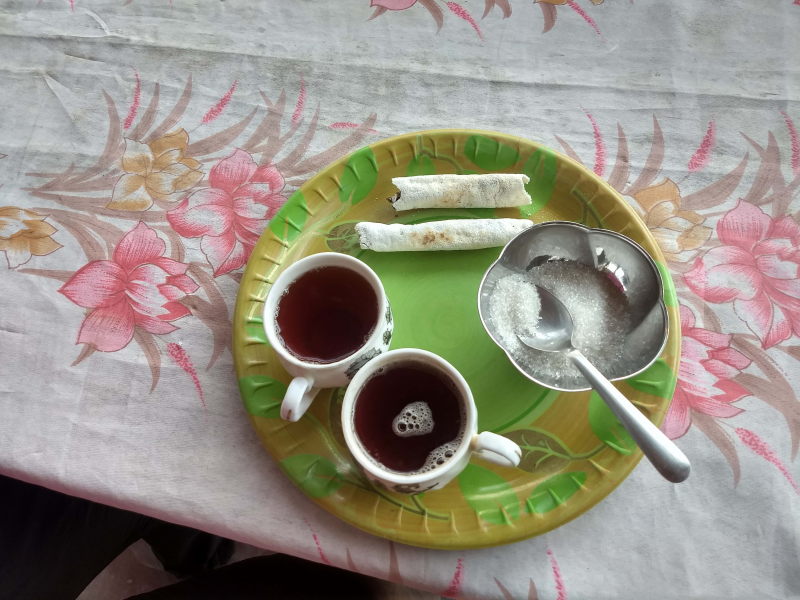
Black tea with rice and sesame rolls.
What to buy from Majuli
Majuli has many Satras with their own unique crafts. But we found most of the crafts very expensive. And most of them would be fragile show pieces, e.g. a dance mask. Nor can you buy an earthern pot and carry it safely to a city like Mumbai, New Delhi or Chennai without splintering it. And we had ridden our motorbike all the way. Practical products you can buy are shawls and Assamese mekhela drape from one of the Satras dedicated to weaving.
Conclusion
It is a unique experience to spend a few days on a river island, watching river dolphins, witnessing community-specific skills, standing by the bank of a gigantic river and staying in a bamboo cottage. For us, it was an anniversary well spent. Now it’s your turn to explore the largest river island in the world right here in India.

